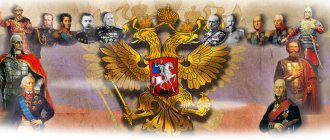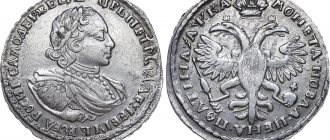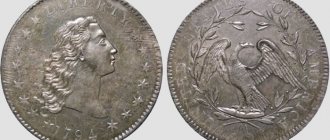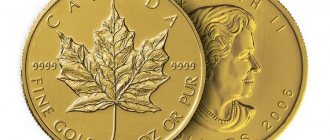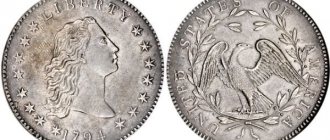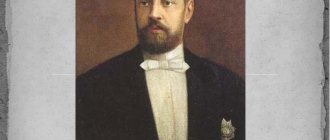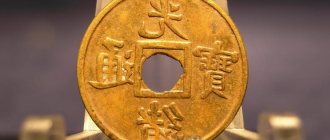Despite the fact that most of the world's coins are made in a compact form, stories about giant money are woven into fairy tales, legends and myths of many peoples of the world. One of these coins even became the heroine of a mathematical problem about the commander Terence and the cunning emperor. At Terence’s request to give him a million denarii as a reward, the emperor made his decision: “You will enter the treasury, take one breaststroke in your hands, return and lay it at my feet. The next day you will take a coin equal to 2 breasts and place it here next to the first one. On the third day you will bring a coin worth 4 breasts, and the fourth - worth 8 breasts, on the fifth - 16, and so on, doubling the value of the coin. I will order that coins of proper value be made for you every day. And when you notice that you can no longer lift the coin, our agreement will end, but everything that you have endured will remain for you and will serve as a reward.” The problem states that Terence surrendered on the eighteenth day, when, using a spear as a lever, he rolled a coin cast from 131,072 brasses into the throne room. It was more than a meter across and weighed 655 kilograms. Considering that the breaststroke in the problem meant a small coin (21 mm in diameter and 5 grams in weight) of a fifth of a denarius, the cunning emperor saved a lot. He gave Terence an amount 19 times less than what the commander had requested. The problem does not say whether Terence left the giant coin as a edification to his descendants. So let's take a look at the largest coins that actually exist.
The largest denomination and heaviest coin
The largest and therefore heaviest coin is the one million dollar gold coin created by artist Stanley Whitten. This 999.99 fine gold coin was minted by the Bank of Canada for the Royal Mint. On one side of the coin there is a portrait of the head of Canada, Queen Elizabeth II, on the other side there is a maple leaf. Each coin took up to eight weeks to make by hand.
The weight of the coin is about 100 kilograms, or more precisely 99.95 kilograms or 221 pounds, diameter - 20 inches or 50.8 cm, thickness -1 inch 2.5 cm. Before it was made, the heaviest coin from Austria was considered to be worth 100,000 euros , whose weight was 31.1 kilograms. 15 coins were issued and they sold out to collections in less than a month. Thus, the new largest and heaviest coin is more than 3 times more solid than its predecessor!
Burial of the ruble
Gravestone ruble, Estonia
There are many monuments to money. They exist both abroad and in Russia. But in Estonia they decided to perpetuate the Soviet ruble differently - to erect a monument to the ruble. After leaving the USSR, Estonia had its own currency, and the ruble went out of circulation. This fact was marked by the construction of a burial place for the ruble in 1992 and the erection of a black marble monument over its symbolic grave, which indicated the dates of the “life” of the ruble in Estonia.
The variety of money around the world, the issuance of commemorative and collectible coins by banks have led to the fact that many people have developed a hobby - collecting money. There are also people who use coins and banknotes as material for creativity: some carve coins, some make origami from banknotes, and others are attracted to crafts made from coins.
And someone is simply trying to find a way to attract money to the house...
The most beautiful coin
The most beautiful coin in the world is rightfully considered the Mexican coin, issued in 2005 from silver with images of the national coat of arms of Mexico and the calendar of the Aztec tribe. The decision to assign this status to the coin was made by members of the World Mint Conference, which took place in May 2008 in South Korea. The value of the coin is not specified. This outlandish coin attracted the attention of the jury not only for its amazing beauty, but also for the complexity of its execution technique. After all, depicting the Aztec monolith “Sun Stone” weighing 24 tons, which is also called a “calendar”, in all details on a small coin is very difficult.
The most unusual banknotes
Banknotes are not only paper. They are also made from other materials - silk, leather, wood, metal and plastic.
In the last century, very unusual banknotes were in use in Russian Yakutia - the so-called “wine money”, or more precisely, wine labels.
Alaska Leather Money
And in Alaska, money made from seal skin was in use. Why? Of course, coins and banknotes that were in circulation throughout Russia at that time were supplied to this region. But, firstly, there were not enough of them, and, secondly, local residents preferred to melt the coins into things needed in everyday life. But there were a lot of seals in Alaska, so it was decided to use pieces of seal skin as money.
Plastic money
Plastic money has a higher cost than paper money, but its service life is much longer. In addition, they are more hygienic - plastic does not absorb dirt, sweat and moisture. The first plastic banknotes were issued in 1983 in Costa Rica and Haiti. But they had to be discontinued because the climate turned out to be stronger than modern technology - under the influence of a hot, humid climate, the paint peeled off from the polymer base. Now plastic banknotes are available in 55 countries around the world.
The largest banknote in human history
The largest note in size
is the Malaysian 2021 RM600 paper note. Its dimensions: 37 cm by 22 cm.
"Football" banknote
Bankton with George Best
In 2005, George Best, one of the best football players in the world of the 20th century, Irish by birth, died. In 2006, Ireland issued a banknote with images of Best scoring goals against the enemy.
The largest coin in Russia in terms of purchasing power
A commemorative coin with a face value of as much as 50,000 rubles of the Russian Federation was released into circulation by the Bank of Russia on February 1, 2010 for its 150th anniversary. The weight of the coin made of pure gold is 5 kilograms, the circulation is 50 copies. This coin serves as legal tender throughout the Russian Federation and is accepted for payment at its face value of 50,000 rubles, although the real value of the coin is several orders of magnitude higher than the nominal value.
On the obverse of the coin, in the center, the state emblem of modern Russia is depicted, framed by all the emblem symbols that existed in its history at the bottom, with the inscription “Fifty thousand rubles” at the top.
On the reverse of the coin in the center is the building of the Central Administration of the State Bank in St. Petersburg in the period from 1860 to 1918, in the foreground there are fragments of the Bank Bridge and two griffins, in the oval medallions at the top there are portraits from right to left: Stieglitz A.L., Alexander II, Lamansky E.I. At the bottom it is written: “BANK OF RUSSIA was founded in 1860.”
The predecessor of this largest coin was a commemorative coin with a face value of 25,000 rubles of the Russian Federation made of 3 kilograms of pure gold, dedicated to the 190th anniversary of the Federal State Enterprise Goznak. The coin was issued by the Bank of Russia on August 11, 2008, its circulation is 50 copies.
An interesting fact: with a five-kilogram gold coin you can make a purchase in any store, for example, buy a gold chain weighing 50-60 grams.
The largest notgeld (bona)
The largest number on a coin is 1 billion. Unique copies worth 1 billion were released in Westphalia in 1923. The material used is silver-plated nickel silver or gilded tombak. Diameter - 60 mm, weight - about 80 g. It is worth noting that this is not a national coin, but a notgeld, i.e. special money made by local authorities or non-governmental organizations in Germany during the great crisis and hyperinflation of 1914–1924. This crisis gave rise to a special type of notgeld - inflationary notgeld. In 1923, a pound of meat cost 3.2 trillion marks, so coins had to be minted in surprisingly large denominations. Notgelds of the province of Westphalia were not legal tender, however, the denomination of this coin is the largest number ever minted on a metal payment item.
In addition to the 1 billion coin, coins were also made in denominations of 50 million marks (copper, aluminum, gold-plated tombac), 5 million marks (diameter - 44 mm, gold-plated tombak or copper, weight - 33 grams, the price depends on the material, reaches 470 euros), ¼ million marks (weight - 1.4 g, aluminum, diameter - 24 mm), etc. The current price of a banknote of 1 billion varies between 800 euros for a copy of nickel silver and 1,650 euros for a copy of gilded tombac.
The heaviest coins of Russia
In the Russian Empire, it was a square copper plate worth 1 ruble of Empress Catherine I with the denomination in the center and the seals-coats of arms of Russia on the four edges. Inscription in a circle: Price ruble. Ekaterinburg. 1725. Its weight was a little more than 1.6 kg, so ten of these coins weighed exactly a pound. The thickness of the coin is 5 mm, size 18x18 cm. The coin was issued in the period from 1725 to 1726 and is now very rare (the collection value of such a coin back in the 60s of the last century was more than two thousand rubles).
In modern Russia, on November 22, 1999, the Bank of Russia issued a commemorative 900 silver coin in honor of the 275th anniversary of the St. Petersburg Mint. The total circulation of the coin is 150 pieces, the denomination is 200 rubles and the weight is 3342 grams. It took more than 3 kilograms of pure silver to make one coin. After that, two more of the same coins were issued: 200 coins made of 925 silver and 300 coins made of 900 silver.
The oldest coin in the world is often considered a stater or two-drachm coin made of an alloy of gold and silver, minted in Lydia or Ionia (Asia Minor) around the 8th century BC. uh..
Rice. 1. Stater from Lydia, early 6th century. BC.
The most expensive coin sold at auction is the “gold Double Eagle” with a face value of only $20, issued in 1933. On July 30, 2002, it was sold under the hammer for a record sum of US$7,590,020.
| In 1933, the US Federal Bank issued 445 thousand $20 gold coins. According to a decree adopted by F. Roosevelt during the Great Depression, “double-headed eagles” were purchased from the population at a price 2.5 times higher than the nominal value. But, as it turned out later, not all the coins were melted down into gold bars. Back in 1933, the US Mint donated two coins to the National Numismatic Collection at the Smithsonian Institute. Today it is not known exactly how many “double eagles” from 1933 actually remain; it is assumed that during the melting of the gold, about 20 coins were illegally left behind. One of the missing double eagles was purchased by King Fuad I of Egypt. In 1944, Fuad I purchased a 1933 double eagle, and he even requested an export license for the coin from the United States Treasury Department. By mistake, such a license was granted. |
The Treasury Department attempted to return the coin through diplomatic channels, but World War II prevented this. In 1952, Fuad I was overthrown in a coup and most of his collection was auctioned by Sotheby's. For 40 years, the history of the coin is shrouded in darkness. In the early 90s, Briton Stephen Fenton appeared in New York with a copy of King Fuad I, from whom the American intelligence service nevertheless confiscated a 20-dollar coin. For several years, a court case was conducted in US courtrooms in which S. Fenton and the US Mint tried to prove the right to own the coin. As a result, in 2001 it was decided that the Double Gold Eagle would be sold at auction, with the proceeds shared between the British collector and the US Mint.
Rice. 2. Double gold eagle 1933
The most valuable coin is considered to be the ancient Greek silver tetradrachm, known among numismatists as the “Etna tetradrachm.” It is the only one that has survived to this day. For more than 100 years, the “tetradrachm of Etna” has been kept in the Royal Library of Belgium. Experts call the ancient Greek coin the “Mona Lisa” of ancient banknotes and value it at $3 million. This coin has never been auctioned, but if offered at auction, the price would probably exceed the value of a double eagle.
The Etna tetradrachm was minted in the Sicilian city of Aitna (Etna) in 476 BC. Its diameter is 2.5 centimeters, weight is 16 grams. On one side of the coin there is an image of Zeus the Thunderer, on the other - a satyr. Unlike the vast majority of ancient coins that have survived to this day, the “tetradrachm of Etna” is in perfect condition and amazes with the skill with which the silver engraving was made.
Rice. 3. Tetradrachm of Etna
In the category of
the largest and heaviest, I would like to allocate several money at once.
The absolute record holder is a heavyweight from Canada; this gold coin with a face value of 1 million (!) Canadian dollars ( the largest coin by denomination) was released in 2007. Weighing nearly 100 kg (220.5 pounds or 99.79 kg), the gold coin has a diameter of 20 inches (50.8 cm) and a thickness of 1 inch (2.5 cm). Gold purity - 99.999%. Only seven of these giants were cast. Before it, the heaviest was the Austrian coin with a face value of 100 thousand euros, weighing 31.1 kg.
But such coins are issued more for advertising than for practical purposes. As the editor of Canadian Coin News noted: “They didn't produce them because there was a big need for 100-kilogram gold coins. They did this to show off the world's largest pure gold coin."
Rice. 4. The heaviest coin in the world
The heaviest metal coins in circulation are the rectangular Swedish 10-daler copper coins, which were issued in the 18th century. One such coin weighs 19 kilograms 710 grams, and has the royal seal stamped on its corners.
These coins were the subject of an exhibition held by the Royal Coin Cabinet in Stockholm last April - “The World's Largest Coin.”
“This new exhibition highlights Sweden's important role in global economic history. For example, the world's first bank began operating in 1668 and is still operating today - this is the State Bank in Sweden. And the Swedes are behind the world's first banknote, which was issued by the Bank of Stockholm in 1661, says Eva Wiesen, responsible for the exhibition at the Royal Coin Cabinet.
Throughout the 17th century. Sweden was a leading copper producer. One of the first reasons for the production of heavy copper coins was that it was easier to transport the plate, which weighs 20 kg.
Today there are about 15,000 plates stored in Sweden and Finland, and about 4,000 more in the world. Coin plates were used between 1644 and 1776. For 116 years, coin plates and banknotes lived side by side, but on January 1, 1777, the use of coin plates as a means of payment and settlement in Sweden was prohibited.
Rice. 5. 10 dalers 1644
In Russia, the largest coin is a square copper plate of 1 ruble of Catherine I with round seals - the coats of arms of Russia on four edges and with the denomination in the center. Inscription in . The weight of the coin is 1.636 kg. Ten coins weighed exactly a pound. Size 18x18 cm, thickness 5 mm. The coin was issued in 1725-1726 and is now extremely rare.
The biggest penny
was issued in 1726 during the reign of Catherine I. It was minted from copper at the Yekaterinburg Platt Yard, its weight was 16.38 g. The kopek was square in shape and dimensions 23x23 mm.
Rice.
6. 1 kopeck 1725
The Modern Bank of the Russian Federation from time to time issues silver coins with a face value of 200 rubles and weighing 3,342 grams. The content of pure silver in such coins is 3 kilograms. And on August 11, 2008, the largest coin in Russia
- a coin with a face value of 25,000 Russian rubles weighing three kilograms of pure gold - the 190th anniversary of the Federal State Unitary Enterprise Goznak. Diameter 12 cm, edition 50 copies.
Rice. 7. 25 thousand Russian rubles
The smallest and lightest coin in the world
according to the Guinness Book of Records - a silver coin in denomination of 1 dam. Its mass is only 0.002 g, it was released in Nepal in 1740.
The most beautiful in the world
A 2005 Mexican coin made of silver with images of the coat of arms of Mexico and the Aztec calendar is recognized. The decision was made by members of the World Mint Conference in South Korea in May 2008. As the ministry emphasizes, the curiosity attracted the attention of the international jury not only for its beauty, but also for the technical complexity of its execution. After all, it is very difficult to reproduce on a relatively small coin the details of the 24-ton Aztec monolith “Stone of the Sun,” called a calendar, whose diameter exceeds 3.5 meters.
Rice. 8. The most beautiful coin in the world
The value of the collection of American and colonial coins collected by the Garrett family from 1860 to 1942 was estimated at a record price.
The richest numismatist in the world is American Bruce McNall. He began collecting coins at the age of eight, when he was given a coin album. While still in college, he provided paid consultations to antique coin dealers in his hometown of Los Angeles. As a history student, McNall and a friend opened their own coin store. Now the value of his “numismatic empire” is estimated at $200 million.
The most interesting story with the name has a small Venetian coin from the sixteenth century. It's called a "gasset". It is from her that the word “newspaper” comes. In 1556, the first printed publication (“Written News”) appeared in Venice, and its cost was determined to be one newspaper. They became so accustomed to this that the name of the coin became the name of the publication.
The most eccentric trick with your collection
was accomplished by numismatist Ernst Steingold: having collected a substantial collection of coins, he covered his... limousine with them. The owner of one of the Las Vegas casinos offered him one million dollars for this traveling exhibition, but the numismatist refused, considering the offered amount too small.
The very first inflation known to us
happened in China, during the Yuan Dynasty (1279-1368). At that time, fewer coins were issued than paper banknotes, and chroniclers reported that banknotes began to be valued cheaper than the paper on which they were printed.
The largest inflation in terms of number of zeros in Europe
happened in Hungary. During the Second World War and after it, inflation swept through all cities and villages, gathering its harvest of zeros. In 1946, Hungary issued banknotes in denominations of 100 million pengo and 1 billion pengo. After the denomination, for a new sign with a face value of 100 million adopengo, they took 20,000,000,000,000,000,000,000,000,000 pengo in the old signs. The situation in Hungary stabilized only after the introduction of a new currency in the country - the forint.
The most unusual collection of coins by ratio (number of coins)/(collection value)
belonged to Art Cole Jersey. His collection consisted of only 1000 copies, but... the cost of the cheapest coin was 15 thousand dollars. We must pay tribute to the numismatist-collector; he regularly paid taxes and donated funds to charity.
The most unusual coin in terms of material
production was released in 2005 in the Democratic Republic of the Congo. This is the first wooden coin to be an official means of payment. The denomination of the coin is 5 francs. The coin features an image of a gorilla and the inscription in French “Let's protect the animal world.” Coin diameter: 40 mm, weight: 2.4 grams, material: maple wood. The approximate value of the coin according to the Krause catalog is 20 US dollars.
To be continued…
The most expensive lot of numismatic auctions in Moscow
50 kopecks. 1929 Lot for 10,000,000 rubles. 2011
In the archives of the Leningrad Mint there is a stamping tool for proof 50 and 10 kopecks, but there is not a single sample of the coins themselves. A few years ago, a fifty-kopeck piece was presented in one of the private collections, the only currently known example of a proof coin minted in 1929. At the Znak auction in 2011, the coin was sold for 10,000,000 rubles. Recently, this price was a record for a Soviet or Russian coin.
The largest denomination of the USSR
The USSR monetary system was constant, so there were no serious nominal jumps in coins. The largest circulation coin is considered to be the “sower” of 1923, 1925 (“golden chervonets”), worth 10 rubles (in 1975–1982, similar copies were issued as souvenirs). The largest denomination of commemorative coins was 150 rubles.
The most expensive coin in the world for 7.6 million dollars.
They paid so much money for the coin not because of the high cost of the metal and its quantity in the coin, but because of its rarity. The “double gold eagle” coin, worth only $20, was issued in 1933. After the US Federal Bank changed its decision to release it into circulation, the previously sold coins were bought back from the public at a price 2.5 times the face value. All but three coins were bought back. Two are now in the Smithsonian Museum, the third was stolen and nothing was known about it for a long time. It was only in 1996 that the coin surfaced from a private Egyptian collector. The company that produced the coin bought it (at what price is unknown) and sold it at an auction in New York in 2008 to a buyer who wished to remain anonymous.
Ritual money
Ritual money, China
The Chinese, many centuries ago and now, have so-called “ritual money” that is issued for the world of the dead. For the Chinese, the afterlife is not something scary and bad at all, but simply another world into which sooner or later all people end up for eternal life. And in that life, in order to exist with dignity, you need money, just like we do. How does money get to the next world? When a person dies, his relatives periodically come to temples, where they burn ritual banknotes in special ovens, thereby transferring the required amount to the deceased through the deities.
What other interesting things can you tell about money?
The world's largest banknote
1 billion trillion pengyo. Hungary. 1946
The 1 billion trillion pengö banknote was issued by Hungary in July 1946 after the introduction of the derivative unit adopengö, equal to two trillion pengö. At the same time, the Egi 1 billion trillion bill was issued.
It was possible to stop inflation in Hungary only a month later, in August 1946, when a new monetary unit was introduced - the forint; the exchange of penge at the rate for forints was 4x1029: 1, which is also an absolute record for all financial systems in the world.
Coins weighing 51.19 g
This category includes not one, but several coins at once, of different denominations. These are 10-kopeck banknotes issued in 1762 and 1796, as well as 5-kopeck banknotes issued during the reign of Empresses Elizabeth, Catherine and the so-called “ring coins”. The latter, by the way, have such an unusual name because of one feature: a pattern in the form of rings is depicted along the edge of the coin. One of these “ring rings” was minted in 1803 (the last one). Despite the prevalence of banknotes weighing 51.19 g, the price of any of these specimens is impressive.
